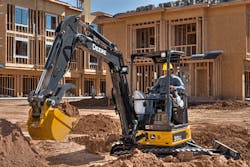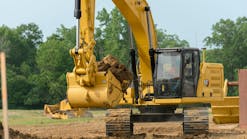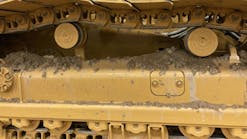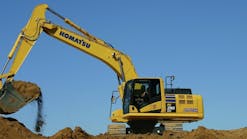Mini excavators have become ubiquitous in the last decade and therefore are a good test case for examining some of the tools available to managers to help keep operating costs down.
There is no substitute, of course, for good operating practices and keeping up with maintenance on minis, but partnering with manufacturers—and their dealers—can open up another world of cost-saving tactics and services.
How far a fleet wants to go in these partnerships is ultimately its decision, but just as with training in the proper uses of technology, equipment dealers play a vital role.
TCO calculators reduce mini excavator costs
Knowing costs and how different parameters affect them is key. Case Construction Equipment, for one example, has a thorough total cost of ownership calculator on its website. It is a small window into the lengths OEMs can go to help track and mitigate costs, assist on maintenance, and more.
To start, Construction Equipment looked at a 37-ton Tier 4-F mini excavator with a purchase date of March 2020. The first two adjustable parameters on the site are the years of estimated ownership and projected machine usage in hours per year. For the sake of the example, three years and 650 hours are used, respectively.
The next inputs needed are purchase price, cost of interest, and resale value. According to Ed Brenton, the company’s mini excavator specialist, the Case CX37C mini excavator with a cab is roughly $60,000. At press time, Case was offering a zero percent for 60 months financing deal on the model, so that value will be zero.
For resale value, a total of $39,000 was entered at Case’s suggestion, and a machine tax per year of $800 was added. There is also a place to enter any money spent on an extended warranty, because such protection does enter into the equation. For this example, a mid-level three-year, 3,000-hour powertrain and hydraulics extended warranty was chosen. These can vary in cost considerably, but a value of $1,000 was used.
This completes the owning costs section of the TCO calculator. Our calculation for Owning Costs sits at $25.13 per hour.
The Operations Costs section on the site contains some fixed values (a $50 per hour operator salary, $2.66 per gallon for diesel) and some values that need to be entered, such as fuel consumption rate (1.5 gallons per hour), how many sets of replacement tracks during the ownership period (1), the cost per set of tracks ($2,000), the daily lubrication cost per year ($1,900), and the cost of comsumables for the year ($500).
Once this data is entered (Case provided some guidance), the Operations Costs came to $58.71 per hour.
A third section, Routine Maintenance Costs, contains a category to set working conditions to normal or extreme. Setting the conditions to normal helps fill in the rest of the parameters, automatically setting labor hours to 16 (with a fixed rate of $100 per hour) and parts costs at $707.65.
Case says the parts and labor values are based on standard routine maintenance at recommended intervals for the machine selected. Changing working conditions to “extreme” would double the service intervals.
In addition to helpful hourly tallies for the owning costs and the operating costs, the calculator gives managers a look at the total estimated cost (including owning, operating, and routine maintenance) for the mini excavator on an hourly ($85.02 for this exercise) and lifetime ($165,795.65) basis.
How maintenance agreements control costs
Manufacturers also offer parts and service programs that can be used on mini excavators to mitigate costs, with ascending levels of sophistication and descending levels of fleet involvement.
Caterpillar is just one manufacturer that offers a thorough set of options, calling theirs Customer Value Agreements (CVA). CVAs can be purchased for a new machine and a Cat-certified used machine (or a Cat machine that’s already in a fleet).
“The big picture [with CVAs] is no downtime,” says Jeff Gatton, owner of Kansas-based JAG Excavating. “Zero amount of downtime is what I’m going for, but I know every day a machine doesn’t break is a day closer to it breaking, and I know if I can avoid that day as long as long as possible, then our profitability just is that much better.”
Cat says every CVA comes with “hassle-free maintenance,” with its parts delivered to the customer location on schedule, and with step-by-step instructions should the fleet want to do its own installation. There are also Equipment Protection Plan (EPP) options to “minimize surprise costs” on covered repairs.
Equipment Health Management provides machine alerts and information through telematics, as well as inspections and fluid health monitoring. And all elements of a CVA are part of one agreement and eligible to be included with the monthly machine payment.
For new machines, there are three levels of CVAs, termed “Convenience,” “Performance,” and “Confidence.” The choice of levels largely depends on how much maintenance a fleet wants to do.
The Convenience level is available in a three-year or one-year agreement and includes Cat parts delivered with instructions on self-installation; planned maintenance kits aligned to the first four PM events; parts and fluids, which vary based on the operation and maintenance manual; a powertrain, hydraulics, and engine EPP that covers defects in material; and company workmanship related to those areas. The EPP aligns with agreed-upon hours and the CVA term.
The Convenience package is designed for operations that handle maintenance work in-house. Its duration can be set up as one or three years. Depending on expected machine hours, it could include 2, 3, 6, or 10 PM kits.
The Convenience CVA includes an EPP, which matches the duration set up with PM kit intervals, by years or working hours. The EPP provides coverage for defects in material and Cat workmanship related to powertrain, hydraulics, and technology. Convenience also introduces advanced Cat Fluids. Like all CVAs, Convenience includes the Cat App and My.Cat.Com to help managers see machine data and provide insights.
The Performance CVA level introduces trained dealer service and maintenance. Dealer service offers flexibility to manage downtime as well as the need for in-house technicians. Routine maintenance, annual inspections, and fluid analysis are performed by a Cat dealer.
This CVA also introduces advanced Cat Fluids. In addition to a three-year agreement duration, this CVA is available in a five-year agreement to extend the EPP and offer more planned maintenance parts kits. Performance includes the same Powertrain, Hydraulics and Technology EPP coverage and connectivity insights as the Convenience level.
Confidence is the third CVA option for a new machine. This option provides the highest level of machine protection and dealer service involvement. It also provides comprehensive equipment protection over a five-year planned CVA duration. It extends EPP coverage to include electronics, cab, brakes, steering, and suspension. Similar to Performance, this CVA includes dealer service allowing flexible PM maintenance with the goal of maximizing uptime.
Unique to this option, it includes milestone maintenance such as 3,000-hour and 5,000-hour service. This CVA includes Cat Fluids and dealer-performed fluid analysis. It also includes dealer support and Connectivity insights through the Cat App and My.Cat.Com, as well as insights of Condition Monitoring via dealer equipment health management and advice.
Owners of used mini excavators can also benefit from a CVA. The Cat Certified Used CVA includes parts delivery before planned maintenance intervals, insights from the Cat App, My.Cat.Com, and Cat Inspect apps. And, this CVA can be also included in the Cat Certified Used machine payment.
“These agreements are truly about bringing value to the customer,” says Rob Kruziki, Caterpillar’s CVA manager. “While there is no doubt that preventative maintenance is the baseline of every CVA, engine uptime, cutting-edge support, and long-lasting relationships are at the core of what we do.”







